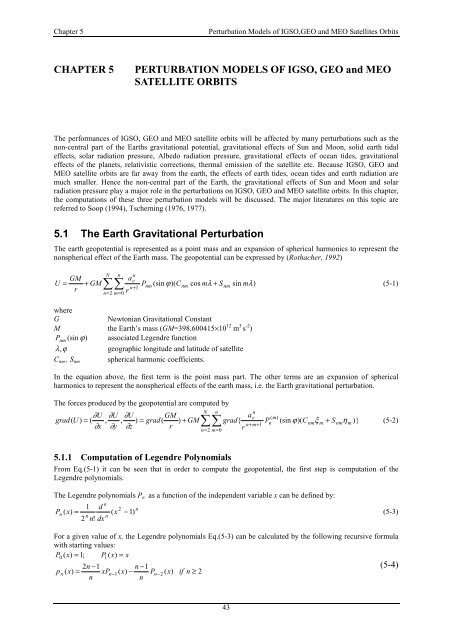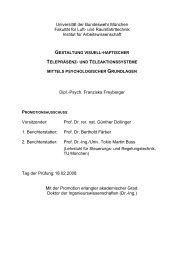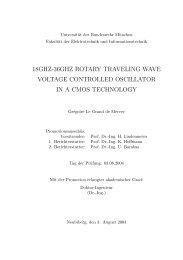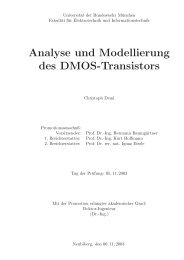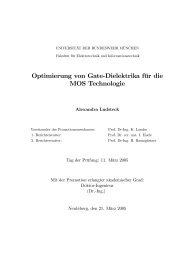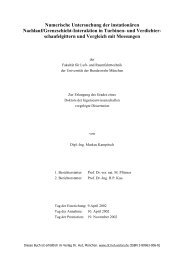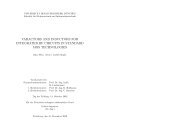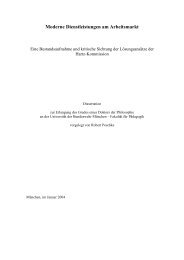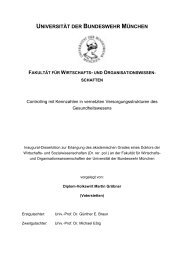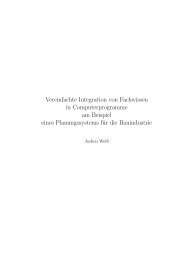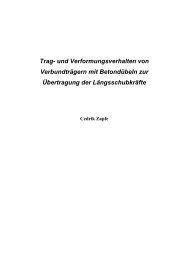Precise Orbit Determination of Global Navigation Satellite System of ...
Precise Orbit Determination of Global Navigation Satellite System of ...
Precise Orbit Determination of Global Navigation Satellite System of ...
Create successful ePaper yourself
Turn your PDF publications into a flip-book with our unique Google optimized e-Paper software.
Chapter 5 Perturbation Models <strong>of</strong> IGSO,GEO and MEO <strong>Satellite</strong>s <strong>Orbit</strong>s<br />
CHAPTER 5 PERTURBATION MODELS OF IGSO, GEO and MEO<br />
SATELLITE ORBITS<br />
The performances <strong>of</strong> IGSO, GEO and MEO satellite orbits will be affected by many perturbations such as the<br />
non-central part <strong>of</strong> the Earths gravitational potential, gravitational effects <strong>of</strong> Sun and Moon, solid earth tidal<br />
effects, solar radiation pressure, Albedo radiation pressure, gravitational effects <strong>of</strong> ocean tides, gravitational<br />
effects <strong>of</strong> the planets, relativistic corrections, thermal emission <strong>of</strong> the satellite etc. Because IGSO, GEO and<br />
MEO satellite orbits are far away from the earth, the effects <strong>of</strong> earth tides, ocean tides and earth radiation are<br />
much smaller. Hence the non-central part <strong>of</strong> the Earth, the gravitational effects <strong>of</strong> Sun and Moon and solar<br />
radiation pressure play a major role in the perturbations on IGSO, GEO and MEO satellite orbits. In this chapter,<br />
the computations <strong>of</strong> these three perturbation models will be discussed. The major literatures on this topic are<br />
referred to Soop (1994), Tscherning (1976, 1977).<br />
5.1 The Earth Gravitational Perturbation<br />
The earth geopotential is represented as a point mass and an expansion <strong>of</strong> spherical harmonics to represent the<br />
nonspherical effect <strong>of</strong> the Earth mass. The geopotential can be expressed by (Rothacher, 1992)<br />
GM<br />
U =<br />
r<br />
+ GM<br />
N<br />
n<br />
��<br />
n=<br />
2 m=<br />
0<br />
r<br />
n<br />
e<br />
n+<br />
1<br />
a<br />
P<br />
nm<br />
(sin ϕ )( C cos mλ<br />
+ S sin mλ)<br />
(5-1)<br />
where<br />
G Newtonian Gravitational Constant<br />
M the Earth’s mass (GM=398.600415×10 12 m 3 s -2 )<br />
Pnm (sin ϕ)<br />
associated Legendre function<br />
λ, ϕ<br />
geographic longitude and latitude <strong>of</strong> satellite<br />
spherical harmonic coefficients.<br />
Cnm , Snm<br />
nm<br />
nm<br />
In the equation above, the first term is the point mass part. The other terms are an expansion <strong>of</strong> spherical<br />
harmonics to represent the nonspherical effects <strong>of</strong> the earth mass, i.e. the Earth gravitational perturbation.<br />
The forces produced by the geopotential are computed by<br />
N<br />
��<br />
n=<br />
2 m=<br />
0<br />
43<br />
n<br />
ae<br />
n+<br />
m+<br />
1<br />
∂U<br />
∂U<br />
∂U<br />
GM<br />
( m)<br />
grad(<br />
U ) = ( , , ) = grad(<br />
) + GM grad{<br />
Pn<br />
(sin ϕ)(<br />
Cnmξ<br />
m + S nmηm<br />
)}<br />
∂x<br />
∂y<br />
∂z<br />
r<br />
r<br />
n<br />
5.1.1 Computation <strong>of</strong> Legendre Polynomials<br />
From Eq.(5-1) it can be seen that in order to compute the geopotential, the first step is computation <strong>of</strong> the<br />
Legendre polynomials.<br />
The Legendre polynomials Pn as a function <strong>of</strong> the independent variable x can be defined by:<br />
n<br />
1 d 2 n<br />
P n ( x)<br />
= ( x − 1)<br />
(5-3)<br />
n n<br />
2 n!<br />
dx<br />
For a given value <strong>of</strong> x, the Legendre polynomials Eq.(5-3) can be calculated by the following recursive formula<br />
with starting values:<br />
P ( x)<br />
= 1;<br />
P ( x)<br />
= x<br />
0<br />
2n<br />
−1<br />
pn<br />
( x)<br />
= xP<br />
n<br />
1<br />
n−1<br />
n −1<br />
( x)<br />
− P<br />
n<br />
n−2<br />
( x)<br />
if n ≥ 2<br />
(5-2)<br />
(5-4)


